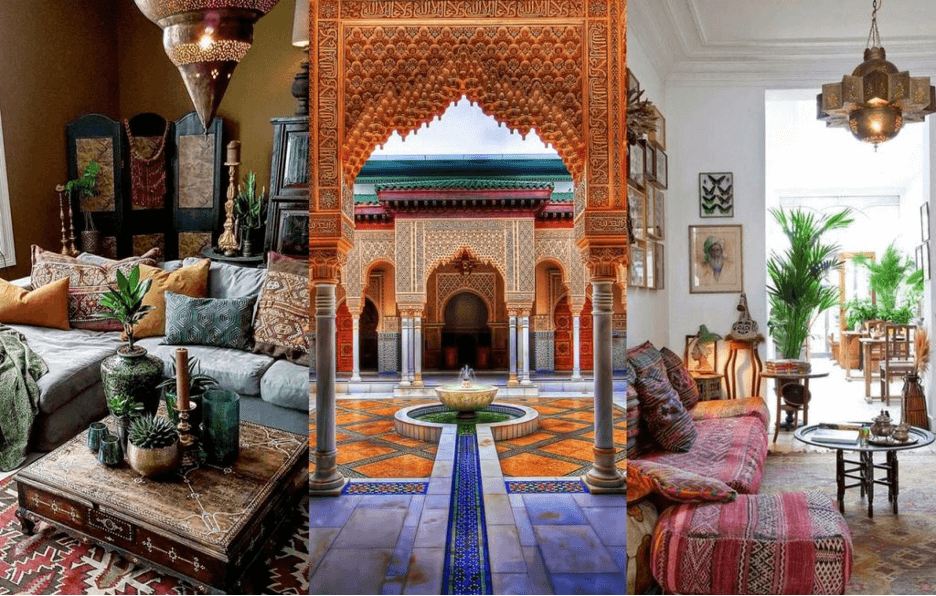When I first stepped into a Moroccan-style home, I was immediately enveloped by rich colors, intricate patterns, and an inviting warmth that felt like a world apart. The influence of Moroccan decor is not just about aesthetics; it’s about immersing oneself in a culture that values craftsmanship, tradition, and the art of hospitality. In this article, I’ll take you through the enchanting world of Moroccan style decor, sharing my personal experiences along the way, and offering practical tips to incorporate this vibrant style into your home.
What is Moroccan Style Decor?
Moroccan decor is a captivating blend of cultural influences from Berber, Moorish, and Mediterranean traditions, characterized by exotic patterns, warm colors, and sometimes a sense of opulence. It emphasizes intricate craftsmanship, textiles, and an inviting atmosphere that encourages social gatherings.
Key Characteristics of Moroccan Decor
- Color Palette: Rich jewel tones like deep reds, vibrant blues, and earthy browns.
- Patterns: Geometric shapes, mosaics, and ornate carvings.
- Textiles: Luxurious fabrics such as silk, wool, and leather with detailed embroidery.
- Lighting: Intricate lanterns and lamps that cast a warm glow.
- Furniture: Low seating arrangements, often with poufs and ottomans.
How to Incorporate Moroccan Style into Your Home
Incorporating Moroccan style into your home doesn’t have to be overwhelming. Whether you’re revamping an entire room or just adding a few accent pieces, there are plenty of ways to create that Moroccan oasis. Based on my personal experience, here’s how you can get started:
1. Choose a Rich Color Palette
Start by selecting a color scheme that evokes the essence of Morocco. Deep reds, vibrant greens, and warm yellows can create a stunning backdrop for your decor. Consider painting an accent wall or using colorful textiles to add warmth.
2. Invest in Textiles
Textiles are at the heart of Moroccan decor. From rugs to curtains, the right fabrics can instantly transform a space. Look for:
- Berber rugs: Authentic and often handwoven.
- Poufs: Soft, leather poufs can serve as additional seating or footrests.
- Cushions: Use patterned cushions on sofas or beds for extra comfort and style.
3. Choose Statement Lighting
Moroccan lanterns and lamps are a must-have for creating the right ambiance. Their intricate designs and warm light add a touch of magic to any space. Consider hanging a large lantern in your living room or using smaller ones on tables for accent lighting.
4. Incorporate Decorative Accents
Add personality with decorative items like:
- Ceramics: Hand-painted Moroccan pottery can add a pop of color.
- Mirrors: Ornate mirrors can help to reflect light and create depth.
- Wall Art: Hang framed Moroccan tiles or traditional paintings to give character to your walls.
5. Embrace Low Furniture
Moroccan rooms often feature low seating arrangements conducive for lounging and socializing. Invest in low coffee tables, cushions, and ottomans to capture this style.

Comparison Table: Key Elements of Moroccan Decor
| Element | Traditional Moroccan | Modern Moroccan |
|---|---|---|
| Color Palette | Deep reds, oranges, and earthy tones | Pastels combined with bold accents |
| Furniture | Low seating and ornate pieces | Minimalistic with statement decor |
| Textiles | Rich, vibrant fabrics | Simplified patterns and lighter materials |
| Lighting | Intricately designed lanterns | Modern design with Moroccan elements |
Pros and Cons of Moroccan Style Decor
Pros
- Rich in culture and history, providing a unique aesthetic.
- Encourages comfy and inviting spaces perfect for entertaining.
- Versatile, allowing for both traditional and modern interpretations.
- Wide range of textures and colors that can enhance any room.
Cons
- Can be overwhelming if not executed thoughtfully.
- Authentic items may be expensive and hard to find.
- May clash with other decor styles if not blended well.
- Requires regular maintenance to keep textiles and surfaces in good condition.
Frequently Asked Questions (FAQs)
1. What materials are commonly used in Moroccan decor?
Common materials include ceramics, wood, metal, and textiles like silk and wool. Each material contributes to the overall texture and warmth of Moroccan style.
2. How can I achieve a Moroccan look on a budget?
Consider thrift shopping for decorative items, using bold textiles, and DIY projects. Even small accent pieces can evoke the Moroccan spirit without breaking the bank.
3. Can Moroccan style work in small spaces?
Absolutely! Opt for lighter color palettes, use mirrors to create the illusion of space, and choose multifunctional furniture to maximize your area.
4. Is Moroccan decor suitable for every climate?
While it is often found in warm, dry climates, Moroccan decor can be adapted for any environment. Just ensure proper ventilation and consider seasonally appropriate textiles.
Conclusion
Embracing Moroccan style decor is a beautiful way to infuse your living space with color, warmth, and culture. Whether you’re fully committing to this aesthetic or simply accenting your home with a few pieces, the charm of Moroccan decor is undeniable. I hope my experiences and tips inspire you to create your own Moroccan-inspired oasis that feels like a personal retreat. Remember, it’s about making choices that resonate with you and bring a sense of joy to your home. Happy decorating!